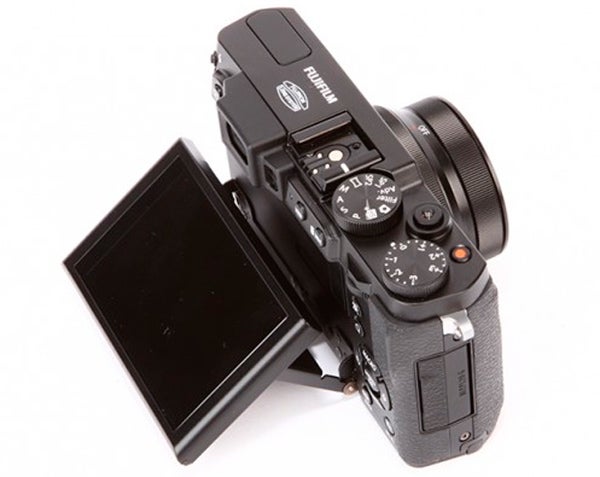Fujifilm X30 Review
Fujifilm X30
Fujifilm's advanced compact takes on the Sony RX100 III

Sections
- Page 1 Fujifilm X30 Review
- Page 2 Image Quality, Performance and Verdict Review
Verdict
Pros
- Great on-body controls
- Fast, accurate AF
- Robust build
Cons
- Smaller sensor than rivals
- No touchscreen
- Lens could offer wider angle
Key Specifications
- Review Price: £479.00
- 28-112mm f/2.0-2.8 lens
- Hybrid AF system
- 12-megapixel 2/3-inch sensor
What is the Fujifilm X30?
The Fujifilm X30 is the follow-up to the popular Fujifilm X20. It’s a high-end, retro-styled compact that sells for £479, making it more expensive than some lower-end CSCs and DSLRs.
Thanks to an excellent new electronic viewfinder and a good hybrid AF system, the Fujifilm X30 manages to justify its position. However, if picture quality is your only, or main, concern, it’s tough to recommend this camera over larger-sensor alternatives such as the Sony RX100 III and its brothers, or the Canon G7 X.

Fujifilm X30 – Design and Handling
The Fujifilm X30 offers similar styling to last year’s X20. Fuji uses a retro metal and leather design throughout its top-end compacts and its compact system camera range, and it’s very easy on the eye.
Like virtually every camera with this sort of design, the leather is actually a mix of rubber and plastic, but provides the grip we’re after. Here, the front part of the hand grip is rubberised, giving way to more conventional plastic on the left side. We’d ideally have liked to see a bit more consistency in a compact as expensive as the Fujifilm X30, but otherwise build quality is great.
Just like the Fujifilm X-E2, it feels as though the X30 could take a lot of punishment before seeing any real ill effects. 
SEE ALSO: Best Cameras Round-up
However, next to super-portable advanced compacts such as the Sony RX100 III and Canon G7 X, the Fujifilm X30 does seem quite chunky. A slightly larger body and hand grip are good for in-hand feel, but may make the camera a bit less convenient.
At 119 x 72 x 60mm and 383g, the Fujifilm is a couple of centimetres bigger in each direction and almost 100g heavier than some of its rivals. If you’re after a camera that can fit in your jeans pocket rather than your coat pocket, this is not it.
However, its controls feel great. There’s a standard PASM mode dial on the top plate, alongside an exposure-compensation dial, but the big change this year is that there are two control wheels on the lens, not one. 
One controls the zoom and is used to turn the Fujifilm X30 on and off, while the other can be customised to cover the main shooting parameters, or side attractions like filters. There’s also a physical switch to alter this on the front. Like other Fujifilm cameras there’s a satisfying tactility that comes with using the X30.
Unlike the aperture rings of expensive DSLR cameras lenses, though, the Fujifilm X30’s lens rings are both smooth, meaning you need to rely on the display read-out to know which setting you’re currently using. This becomes a big bonus when you’re shooting video, with no clicky feedback to introduce judder in your footage.
Fujifilm X30 – EVF
The other important addition, and an area where the Fujifilm X30 is able to beat the competition, is its EVF. Last year’s X20 didn’t have one, instead using an optical viewfinder with an overlay that only offers around 85 per cent coverage of the field – it wasn’t that accurate.
This year, the Fujifilm offers 100 per cent coverage with its EVF, and is easily one of the best EVFs we’ve seen in a camera of this class. It offers 2.36 million dots and is a 0.39-inch OLED unit, providing excellent contrast and a very sharp image. It’s able to render fine details in a way that most EVFs simply can’t.
We find this to be much more satisfying to use next to the lower-res Sony RX100 III EVF and the technically solid but poorly implemented EVF of the Panasonic Lumix LX100. I found myself using the viewfinder as the main composition tool, relegating the rear display to occasional use. That’s a big compliment for any EVF, let alone one in a compact camera.
The Fujifilm X30 handily uses a sensor to detect when you want to use the EVF, switching displays with the rear screen in just a fraction of a second. When working in tandem with the satisfying on-body controls it makes the X30 a joy to shoot with.
Fujifilm X30 – Screen
While it’s likely to be overshadowed a little in favour of the headline-grabbing EVF, Fujifilm has also made big improvements to the rear display. Last year’s Fujifilm X20 used a rather disappointing 460k-dot 3-inch display. It simply is, and always was, too low-res for a high-end compact.
However, this year the Fujifilm X30 clears all that up. It’s still 3-inch but has 921k dots, on par with the competition. It’s back up to speed. 
You don’t get touch operation, but touchscreens are still far from ubiquitous in cameras, and many don’t have much use for them.
Fujifilm’s provided the sort of tilt mechanism that we’re most keen on, though. The display tilts up and down on a pull-out hinge, allowing it to turn 90 degrees to point upwards or around 45 degrees the other way.
An increasing number of cameras seem to be adopting the ‘selfie’-style hinge that flips around a single direction so that it faces you, should you want to take a picture of yourself. However, the Fujifilm X30’s dual-directional tilt is more flexible, allowing you to shoot both above and below head level while keeping an eye on your shot.


